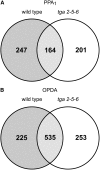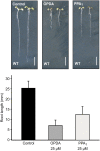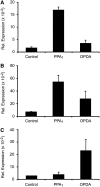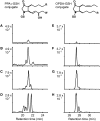General detoxification and stress responses are mediated by oxidized lipids through TGA transcription factors in Arabidopsis
- PMID: 18334669
- PMCID: PMC2329937
- DOI: 10.1105/tpc.107.054809
General detoxification and stress responses are mediated by oxidized lipids through TGA transcription factors in Arabidopsis
Abstract
12-oxo-phytodienoic acid and several phytoprostanes are cyclopentenone oxylipins that are formed via the enzymatic jasmonate pathway and a nonenzymatic, free radical-catalyzed pathway, respectively. Both types of cyclopentenone oxylipins induce the expression of genes related to detoxification, stress responses, and secondary metabolism, a profile clearly distinct from that of the cyclopentanone jasmonic acid. Microarray analyses revealed that 60% of the induction by phytoprostanes and 30% of the induction by 12-oxo-phytodienoic acid was dependent on the TGA transcription factors TGA2, TGA5, and TGA6. Moreover, treatment with phytoprostanes and 12-oxo-phytodienoic acid inhibited cell division and root growth, a property also shared by jasmonic acid. Besides being potent signals, cyclopentenones and other lipid peroxidation products are reactive electrophiles that can covalently bind to and damage proteins. To this end, we show that at least two of the induced detoxification enzymes efficiently metabolize cyclopentenones in vitro. Accumulation of two of these metabolites was detectable during Pseudomonas infection. The cyclopentenone oxylipin gene induction profile resembles the defense response induced by a variety of lipophilic xenobiotics. Hence, oxidized lipids may activate chemosensory mechanisms of a general broad-spectrum detoxification network involving TGA transcription factors.
Figures







Similar articles
-
TGA transcription factors and jasmonate-independent COI1 signalling regulate specific plant responses to reactive oxylipins.J Exp Bot. 2013 Feb;64(4):963-75. doi: 10.1093/jxb/ers389. Epub 2013 Jan 23. J Exp Bot. 2013. PMID: 23349138 Free PMC article.
-
TGA2 signaling in response to reactive electrophile species is not dependent on cysteine modification of TGA2.PLoS One. 2018 Apr 2;13(4):e0195398. doi: 10.1371/journal.pone.0195398. eCollection 2018. PLoS One. 2018. PMID: 29608605 Free PMC article.
-
Arabidopsis thaliana class-II TGA transcription factors are essential activators of jasmonic acid/ethylene-induced defense responses.Plant J. 2010 Jan;61(2):200-10. doi: 10.1111/j.1365-313X.2009.04044.x. Epub 2009 Oct 12. Plant J. 2010. PMID: 19832945
-
SA-inducible Arabidopsis glutaredoxin interacts with TGA factors and suppresses JA-responsive PDF1.2 transcription.Plant J. 2007 Apr;50(1):128-39. doi: 10.1111/j.1365-313X.2007.03039.x. Plant J. 2007. PMID: 17397508
-
Impact of cyclopentenone-oxylipins on the proteome of Arabidopsis thaliana.Biochim Biophys Acta. 2008 Dec;1784(12):1975-85. doi: 10.1016/j.bbapap.2008.09.003. Epub 2008 Sep 20. Biochim Biophys Acta. 2008. PMID: 18848650
Cited by
-
Singlet oxygen-mediated signaling in plants: moving from flu to wild type reveals an increasing complexity.Photosynth Res. 2013 Oct;116(2-3):455-64. doi: 10.1007/s11120-013-9876-4. Epub 2013 Jul 7. Photosynth Res. 2013. PMID: 23832611 Free PMC article. Review.
-
Responses of Soybean Genes in the Substituted Segments of Segment Substitution Lines Following a Xanthomonas Infection.Front Plant Sci. 2020 Jul 2;11:972. doi: 10.3389/fpls.2020.00972. eCollection 2020. Front Plant Sci. 2020. PMID: 32719700 Free PMC article.
-
The Glutathione S-Transferase PtGSTF1 Improves Biomass Production and Salt Tolerance through Regulating Xylem Cell Proliferation, Ion Homeostasis and Reactive Oxygen Species Scavenging in Poplar.Int J Mol Sci. 2022 Sep 25;23(19):11288. doi: 10.3390/ijms231911288. Int J Mol Sci. 2022. PMID: 36232609 Free PMC article.
-
The presence of oxygenated lipids in plant defense in response to biotic stress: a metabolomics appraisal.Plant Signal Behav. 2021 Dec 2;16(12):1989215. doi: 10.1080/15592324.2021.1989215. Epub 2021 Dec 30. Plant Signal Behav. 2021. PMID: 34968410 Free PMC article. Review.
-
A bacterial biosynthetic pathway for methylated furan fatty acids.J Biol Chem. 2020 Jul 17;295(29):9786-9801. doi: 10.1074/jbc.RA120.013697. Epub 2020 May 20. J Biol Chem. 2020. PMID: 32434926 Free PMC article.
References
-
- Alary, J., Gueraud, F., and Cravedi, J.P. (2003). Fate of 4-hydroxynonenal in vivo: Disposition and metabolic pathways. Mol. Aspects Med. 24 177–187. - PubMed
-
- Almeras, E., Stolz, S., Vollenweider, S., Reymond, P., Mene-Saffrane, L., and Farmer, E.E. (2003). Reactive electrophile species activate defense gene expression in Arabidopsis. Plant J. 34 205–216. - PubMed
-
- An, Y.Q., McDowell, J.M., Huang, S., McKinney, E.C., Chambliss, S., and Meagher, R.B. (1996). Strong, constitutive expression of the Arabidopsis ACT2/ACT8 actin subclass in vegetative tissues. Plant J. 10 107–121. - PubMed
-
- Baerson, S.R., Sanchez-Moreiras, A., Pedrol-Bonjoch, N., Schulz, M., Kagan, I.A., Agarwal, A.K., Reigosa, M.J., and Duke, S.O. (2005). Detoxification and transcriptome response in Arabidopsis seedlings exposed to the allelochemical benzoxazolin-2(3H)-one. J. Biol. Chem. 280 21867–21881. - PubMed
-
- Benjamini, Y., and Hochberg, Y. (1995). Controlling the false discovery rate: A practical and powerful approach to multiple testing. J. R. Stat. Soc. Ser. B (Methodological) 57 289–300.
Publication types
MeSH terms
Substances
LinkOut - more resources
Full Text Sources
Other Literature Sources
Molecular Biology Databases

